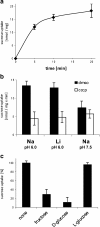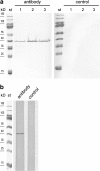Putative role of an SLC45 H+/sugar cotransporter in mammalian spermatozoa
- PMID: 28689241
- PMCID: PMC5629229
- DOI: 10.1007/s00424-017-2024-9
Putative role of an SLC45 H+/sugar cotransporter in mammalian spermatozoa
Abstract
In the present study, we describe the detection and analysis of a novel type of sugar transporter in mammalian spermatozoa. This transporter belongs to the SLC45 family for which two features are remarkable and distinguish it from other known families of sugar transporters. Firstly, SLC45 transporters recognise not only the monosaccharides glucose or fructose but also the disaccharide sucrose as a substrate. Secondly, the uptake of sugars is coupled to a proton gradient. Uptake experiments using radioactively labelled sucrose indicated a functional transporter of the SLC45 family in bull spermatozoa. Real-time PCR as well as Western blots demonstrated the occurrence of the SLC45 member A4 in mouse testis and sperms. Furthermore, immunocytochemical analysis of mouse tissues revealed that the signal of SLC45A4 was mainly located in the principle piece of spermatozoa. We postulate that the SLC45A4 transporter plays an important role in nutrition of spermatozoa during their maturation in the epididymis. Moreover, we suggest that knowledge about the presence of the SLC45A4 may be useful also for the methodical improvement of cryopreservation of mammalian spermatozoa.
Keywords: Proton-coupled sugar transporter; SLC45A4; Spermatozoa maturation.
Conflict of interest statement
The authors declare that they have no conflict of interest.
Figures





Similar articles
-
Interaction of mammalian and plant H+/sucrose transporters with 14-3-3 proteins.Biochem J. 2018 Oct 22;475(20):3239-3254. doi: 10.1042/BCJ20180293. Biochem J. 2018. PMID: 30237153
-
Proton-associated sucrose transport of mammalian solute carrier family 45: an analysis in Saccharomyces cerevisiae.Biochem J. 2014 Dec 1;464(2):193-201. doi: 10.1042/BJ20140572. Biochem J. 2014. PMID: 25164149
-
The SLC45 gene family of putative sugar transporters.Mol Aspects Med. 2013 Apr-Jun;34(2-3):655-60. doi: 10.1016/j.mam.2012.05.014. Mol Aspects Med. 2013. PMID: 23506898 Review.
-
Putative role of the H(+)/sucrose symporter SLC45A3 as an osmolyte transporter in the kidney.Pflugers Arch. 2016 Aug;468(8):1353-62. doi: 10.1007/s00424-016-1841-6. Epub 2016 May 26. Pflugers Arch. 2016. PMID: 27228996
-
GLUTs and mammalian sperm metabolism.J Androl. 2011 Jul-Aug;32(4):348-55. doi: 10.2164/jandrol.110.011197. Epub 2010 Nov 18. J Androl. 2011. PMID: 21088231 Review.
Cited by
-
A systems biology framework integrating GWAS and RNA-seq to shed light on the molecular basis of sperm quality in swine.Genet Sel Evol. 2020 Dec 8;52(1):72. doi: 10.1186/s12711-020-00592-0. Genet Sel Evol. 2020. PMID: 33292187 Free PMC article.
-
Non-Synonymous Variants in Fat QTL Genes among High- and Low-Milk-Yielding Indigenous Breeds.Animals (Basel). 2023 Feb 28;13(5):884. doi: 10.3390/ani13050884. Animals (Basel). 2023. PMID: 36899741 Free PMC article.
-
Melanosome Biogenesis in the Pigmentation of Mammalian Skin.Integr Comp Biol. 2021 Oct 14;61(4):1517-1545. doi: 10.1093/icb/icab078. Integr Comp Biol. 2021. PMID: 34021746 Free PMC article. Review.
-
Database mining analysis revealed the role of the putative H+/sugar transporter solute carrier family 45 in skin cutaneous melanoma.Channels (Austin). 2021 Dec;15(1):496-506. doi: 10.1080/19336950.2021.1956226. Channels (Austin). 2021. PMID: 34334114 Free PMC article.
References
-
- Akamine R, Yamamoto T, Watanabe M, Yamazaki N, Kataoka M, Ishikawa M, Ooie T, Baba Y, Shinohara Y. Usefulness of the 5′ region of the cDNA encoding acidic ribosomal phosphoprotein P0 conserved among rats, mice, and humans as a standard probe for gene expression analysis in different tissues and animal species. J Biochem Biophys Methods. 2007;70:481–486. doi: 10.1016/j.jbbm.2006.11.008. - DOI - PubMed
-
- Angulo C, Rauch MC, Droppelmann A, Reyes AM, Slebe JC, Delgado-Lopez F, Guaiquil VH, Vera JC, Concha II. Hexose transporter expression and function in mammalian spermatozoa: cellular localization and transport of hexoses and vitamin C. J Cell Biochem. 1998;71:189–203. doi: 10.1002/(SICI)1097-4644(19981101)71:2<189::AID-JCB5>3.0.CO;2-R. - DOI - PubMed
Publication types
MeSH terms
Substances
Grants and funding
LinkOut - more resources
Full Text Sources
Other Literature Sources

